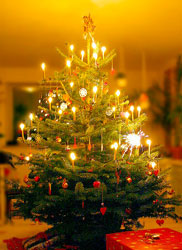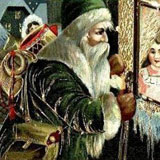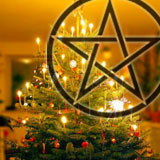It's the Most Pagan-ful Time of the Year
We all know the reason for the season: the birth of Jesus. Too bad Christmas has little to do with Jesus or Christianity. You may be thinking, "What is he talking about? All the Christmas festivities revolve around the birth of the Lord." I guess you're right, the Christmas tree is symbolic of...um...the evergreen that miraculously bore pomegranates to feed Mary and Joseph on their trek to Bethlehem. Mistletoe is there to remind us of how shepherds used...mistletoe to...make sheep kiss each other. See my point?
I decided to investigate the true meaning of Christmas by discovering the reasons for its elements. Let's look at them one by one.

The Christmas Tree: Pagan. Evergreens were special in many pagan cultures. They were symbolic of the return of summer and longer, sunnier, greener days. They also were displays of life triumphant over death. Romans, Egyptians and Celts would decorate homes and temples with evergreen trees and boughs. Christians went through a love/hate relationship with Christmas Trees. Puritans thought they were evil (shocker!). They were popularized by Queen Victoria in 1846. She may also be responsible for the gaudy decorations that are now put on trees.
Stockings: Pagan Christian Fusion. There seems to be 2 sources. First, Germanic Pagans would set out shoes filled with hay or other horse foods to feed Odin's flying horses during the Yule times. People were afraid of Odin so they wanted to appease him. Second, it is said that St. Nicholas put coins in the chimney-side socks of poor girls that had no dowries. So, if you're afraid of God or are too poor to get married, leave a stocking out.
Nativity Scene: Christian. This one is pretty obviously Christian. However, I have suspicions about the Three Wise Men. I'm not sure they were Jews.
December 25: Pagan. Jesus was not born on December 25th. Pope Julius I decided to put Christmas on the 25th because that was when the Romans observed the worship of Mithra, the God of the Unconquerable Sun. It made an easy transition for Pagans who had converted to Christianity. Shepherds didn't "watch their flocks by night" during winter. They were busy wrapping Christmas presents, duh.
Mistletoe: Pagan. The Celts believed mistletoe was a magical plant that could heal wounds and increase fertility. They would hang mistletoe for those reasons. Kissing under mistletoe came into play during the Victorian Era, uptight Victorians used the plant to justify their wicked sexual kissing urges. Naughty!

Poinsettias: Christian? Poinsettias are a Mexican plant. It is thought that Mexican Fransiscans used them as Christmas decorations during the 17th century. There is also some debate about how the word poinsettia is pronounced. Maybe that's because of where I grew up.
Wreaths: Pagan. This includes holly, ivy and other greeneries. Similar to the Christmas Tree, evergreen plants were considered sacred to Pagans as symbols of life and sunny times. It was also believed that evergreens could ward off evil spirits and illness. They could also keep your bathtub shiny and piny fresh.
Advent Candles: Mostly Christian. Five candles (3 purple or blue, 1 pink or red and 1 white) are arranged on a wreath. They are symbolic of hope, peace, love, joy and Christ. This goes back centuries in the history of Christianity. I say mostly Christian because the candles are Christian but wreaths are not. Also, it can be difficult to find purple candles. If we are so Christian here in America, why is it hard to find purple candles?
Yule Logs: Pagan. In Norse countries men would bring rare logs to burn during Yule (December 21-Januray 1). It was believed that each spark from the fire represented new livestock that would be born in the coming year. Now we stuff candles in a log and hot glue crap on it. Hot glue doesn't make it Christian.

Santa Claus: Pagan Christian Fusion. As discussed in the stocking example, Santa is a mix of St. Nicholas and the God Odin. Read more in my other essay.
Gluttonous Eating: Pagan? In Rome, Saturnalia was observed for one month beginning the week before solstice. During this month there was much eating and mirth making. I would also point out that this may not be entirely pagan. I have observed most people are big fat pigs regardless of religious affiliation.
Candy Canes: Christian. Stories say that candy canes originated in Germany and were used to keep children's mouths closed during church services and live nativity scenes. Yes, candy canes are gobstoppers or as the Germans say, "Gobbschtopperen".
Wassail: Pagan. Wassail was ale with added spices and apple juice. Traditionally, part of the Wassail was offered to the orchards to ensure their continued fertility. It was part of the Solstice celebration. If you make wassail, please dont put pineapple juice in it. That's really disturbing.
December 2007










